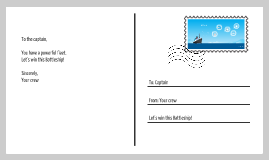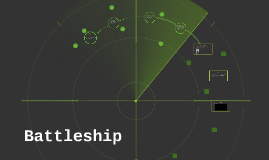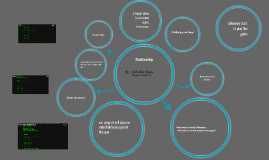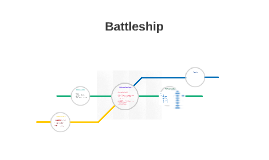Battleship
Transcript: You Sunk My Continuous Battleship! Introduction A battleship is a heavy armored warship. This is the largest ship in a navy fleet, containing heavy caliber guns, and is steam or battery powered. The first battleships were reported as early as the 15th century, when the "ship of the line" tactic was adopted. Up until the late 17th century, the main ship in the fleet was the battleship, with shooting power strong enough to destroy the mast, hull, and crew of an opposing ship. However, the range of this shooting power was limited, so any battle was at a close range with little to no wind. As science flourished in the 18th and 19th centuries, the design of the battleships became more sophisticated. The French introduced steam power to the battleship line. Advantages of steam-power included speed, allowing the ship to travel up to 15 knots, and such the wind conditions were irrelevant. This is the first steam battleship in 1850, called Le Napoleon. In the 19th century, the ship of the line was overtaken by steam-power, and the wooden ships were now ironclad. In 1859, the French introduced the first ironclad ship, called La Glorie. A year later, the Royal Navy launched their first ironclad, the HMS Warrior. These pre-dreadnought ships were replaced in the early 20th century when the Royal Navy launched the first 'dreadnought'--a steel battleship with an 'all-big-gun'--in 1906. From then on, the world Navies modeled their fleets of battleships from this dreadnought design. In the two World Wars, much of the battle centered around the Navies and their battleships--Battle of Moon Sound, Pearl Harbor, Battle of Jutland between the British and Germany, etc. These new dreadnought ships allowed for more speed and a greater shooting range. Motivation Parameters Equations Possible Outcomes Analysis Steady States You may notice... Applications What the Model is Missing By Jennifer Carr, Mark Day, Heather Fertig, Nathan Reaves, Marie Samere, Caroline Simpkins Resources Our Model of a Real Life Battleship is very general. We designed our model to take into account different Navy efficiency at battling. We took navel size and killing efficiency into account when constructing our models. We figured that the size or our navy and the size of an opponents navy would have an effect on killing efficiency and thus the reduction rate of each others navy. This shows that alpha and beta are inverses of each other This makes sense because your kill rate would be related to your opponents kill rate in some way The model for our paper was for the Battleship boardgame, so for the project we decided to create a model for the Battleship movie coming out soon. This model can be used to predict the outcome of any type of war. Firstly, this model can help predict an outcome of a battle in the seas. It can also be applied to human deaths and used to predict the outcome of wars on land or destroying different bases. The model does not account for ships that are hit and are no longer affected in battle. The model also does not include when new ships are built and sent into the war There is no consideration of if there is a depletion of supplies and how often the ships can be restocked Edelstein-Keshet Leah ,“Mathematical Models in Biology” University of British Columbia Vancouver, British Columbia, Canada, Society for Industrial and Applied Mathematics, 2005 Brown, D. K. The Grand Fleet: Warship Design and Development 1906-1922. Caxton Editions. p.208 (2003) Brown, D. K. Warrior to Dreadnought: Warship Development 1860-1905. Book Sales (2003) Friedman, Norman U.S. Battleships: An Illustrated History. Naval Institute Press (1984) Dr. Nick Cogan's Battleship model was also used as a resource. When looking at our model and thinking about real life battleship we found 3 steady states 1. The First Steady state would be when both Navies kill each other off at the same time making the steady state (M, O) = (0,0) 2. The Second Steady State would be when all of our ships are destroyed by the enemy making the steady state (M, O) = (0, O) 3. The Third Steady State would be when all of our opponent's ships are destroyed by our ships making the steady state (M, O) = (M, 0) http://math.rice.edu/~dfield/dfpp.html When each team has the same amount of ships If a > b then the opponents will always win If a < b then our team will always win When the opponents have more ships If a > b then the opponents will always win If a < b then the opponents will win as long as the ratio of their ships to ours is greater than a. We will win if the ratio of their ships to ours is less than a. When we have more ships If a < b then our team will always win If a > b then our team will win as long as the ratio of our ships to theirs is greater than b. The opponents will win if the ratio of our ships to theirs is less than b.

















